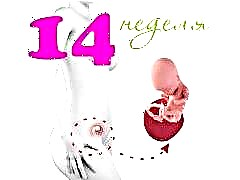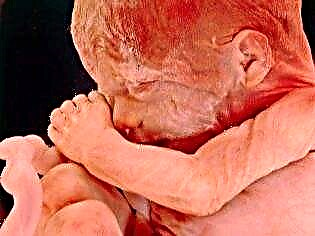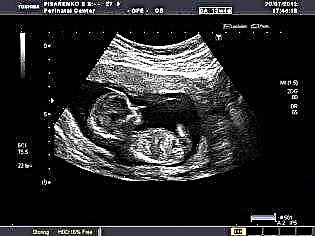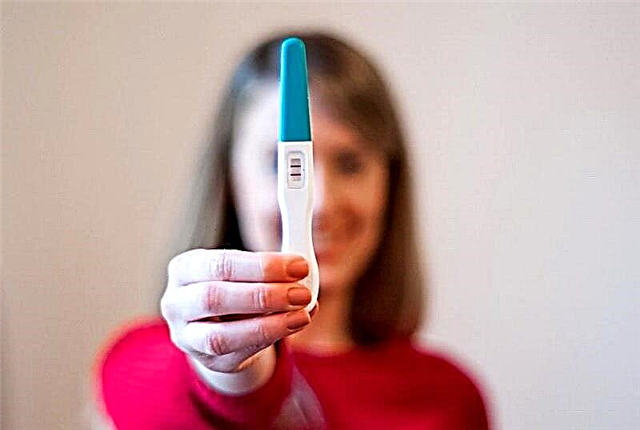
If a woman is in the 14th obstetric week of pregnancy, then her baby is already 12 weeks old. That is how much time the baby is in the mother's womb and develops. A full three lunar months for him is an eternity, because from a set of cells your crumb has turned into a little man, having traveled a path repeating all stages of human evolution. What successes the baby has achieved this week and what is happening right now, we will tell you in more detail.

What is the name of the child?
It is a mistake to call a baby at 14 weeks an embryo. The early embryonic and late embryonic periods of its development are long gone. He was an embryo until the ninth week. After this period, the formation of internal organs was completed, all the processes of laying were over and the embryonic tail disappeared. Now an ordinary tailbone flaunts in its place.
Goes now fetal period, during which a fully formed baby, which is now correctly called a fetus, will grow, gain weight, improve his skills and abilities. This week, the size of the baby is like a large apple, his height is at the level of 12-14 centimeters, and his weight has almost approached the mark of 40-50 grams.

What does a baby look like?
The kid is very much like a man, small and miniature, but already a man. He no longer has a tail, he does not have a giant oval head of irregular shape. With the end of the embryonic phase, more and more human features appear in the form of a baby. Now his head is aligned in shape, rounded, a neck has appeared and the baby at the current time has even learned to own it - he turns his head to the right and left.
The head still remains quite large, but now it is no longer two-thirds of the body area, but only half, and as it grows further, it will become proportional: by childbirth, it will make up only one-fifth of the total proportions. The limbs also look disproportionate - the arms are still longer than the legs, but shorter than necessary - with them the baby only reaches his face and cannot, for example, touch his head - does not reach.


If now a woman is given not the usual two-dimensional ultrasound, which is recommended to everyone as an examination in the framework of prenatal screening, but 3D or even 4D, then the woman will most likely be very surprised to see on the scanner monitor not a cute baby, as women imagine him , but a thin, skinny and wrinkled little man. Subcutaneous fat has not yet formed, this is what gives the appearance of the crumbs such a pronounced suffering thinness.
The skin has a rich red-purple color due to the blood vessels that shine through it. Hair appears on the head of some children at this time, but for now they are light, discolored, since the crumbs have not yet produced a pigment coloring them. This week, the baby has eyebrows that are also very light.
The toes on the arms and legs are already fully formed, there are nails. And this week, the crumbs have individual, unique, characteristic only fingerprints, a unique pattern is formed on them.


The features of the little face change. More and more individuality appears in them. The frontal bone, cheekbones and chin begin to protrude slightly forward at 14 weeks, the growth of the nasal bones also continues. Even now, the baby looks like a mom or dad, it's just that this similarity is still very difficult to catch.
The baby's ears almost fell into place, the eyes also took a position on both sides of the bridge of the nose. The organs of vision are tightly covered by the formed eyelids. This does not prevent the baby from starting to distinguish between darkness and light this week. If, under ultrasound control, you shine a flashlight on the pregnant belly, the baby will become more active and will begin to move faster.
With the auditory function, so far, everything is also ambiguous. The kid hears, but does it in a special way. It picks up the vibration of a sound, such as Mom's voice.
He already distinguishes the vibration of his father's voice from his mother's and can be frightened when sharp and loud extraneous sounds that have nothing to do with the voices of his parents reach him. The inner ear, which is engaged in the transformation of sound waves, will begin to fully function only after a month and a half. But now the baby needs communication, you need to talk to him, read fairy tales to him, sing songs - he will perceive everything on a vibrational level.

Nervous system
The nervous system develops more actively than others; complex and interesting processes take place in it. Until that time, all the impulses that arose in the child's body at the neural level, "caught" the spinal cord. Now he is transferring this honorable duty to the brain. This most important organ is already fully formed, divided into hemispheres, the amount of brain matter is increasing at a very rapid rate.
The kid "grows smarter" every day by a quarter of a million new brain cells.
The pituitary gland produces hormones, and the cerebellum begins to coordinate the movements of the fetus. True, this process is long, and even by the time the baby is born, his movements will be chaotic for a long time.


Primary coordination of motor functions takes place around the clock. Despite the fact that 99% of the time the child spends in a state similar to sleep, his movements do not stop. He shudders, moves his arms and legs, sets in motion the muscles of his face and back. This is due to the fact that neural connections are established between the brain and the muscles of the body, ensuring the rapid passage of nerve impulses.
Even now, the baby can “boast” of possessing some reflexes important for survival - by 13-14 obstetric weeks, the child has learned to suck, grab, swallow and quickly respond to frightening factors, shrinking when frightened. He also pushes off with his legs from the uterine wall when accidentally touched - this reflex will then help him learn to walk.
The taste buds on the tongue and inner surface of the cheeks are well developed - the baby distinguishes shades of tastes, already in the womb giving preference to sweet over bitter or sour. Mom needs to remember this when shaping her diet.
However, a large amount of sweets in an attempt to "please" the fetus can lead to the development of diabetes in pregnant women and increase the risk of developing this disease in the future in the baby.

By the 14th week of the mother's pregnancy and the 12th week of her intrauterine life, the baby comes up with an impressive "baggage" of new knowledge - he, being in the mother's womb, actively learns the world - listens, catches the mood of the mother, learns to interact.
Internal organs
At this time, the placenta, although it is young, but it fully assumes the responsibility for feeding and protecting the baby. Vessels, umbilical cord strengthen and grow. Now the baby and the "child's place" are one whole, and the baby is completely dependent on the health and condition of the placenta. All internal organs have long completed their formation, this week they increase in size and begin to function.
The stomach can now receive amniotic fluid, which the baby swallows in considerable quantities, the intestine contracts rhythmically, "rehearsing" peristalsis, the gallbladder accumulates bile, the liver participates in hematopoiesis. The pancreas produces insulin, the small kidneys produce secondary urine, and the urinary system drains urine from the baby's body into the amniotic fluid. The sterility of the waters is provided by the shells of the amnion - they renew the composition of the waters every 3-4 hours so that they remain clean.

The heart of a child is no different anatomically from an adult heart, it supplies blood to the entire small organism and works very diligently - the fetal heart pumps up to 20 liters of blood per day. Its work can be judged by the heart rate. At week 14, it is normally 157 beats per minute.... Other values are acceptable as long as they are in the range of 146 to 168 beats per minute.
Is it possible to determine the gender?
Theoretically, at 14 weeks, you can determine the sex of the baby. But in practice it is quite difficult to do this - the external genitals are still so small that only a very experienced doctor with a very good ultrasound scanner can catch the differences in them. But even such a doctor will not give guarantees of the accuracy of his "prognosis", advising him to ask a question about gender at the next scheduled ultrasound scan after 18 weeks of pregnancy.
The development of the external genital organs is almost complete. Now the genital tubercles of boys have already become penises, and the girls' ones bend down, forming the clitoris and labia. In the body of future men, the hormone testosterone is already synthesized, and in girls, the ovaries migrate from the abdominal cavity, where they formed and developed, into the small pelvis to the place provided for them by nature. There are already over 2 million eggs in girls' ovaries. In male fetuses, the prostate gland will form at this time.

Bone and muscle growth
Bone tissue is developing very actively this week. The thyroid gland functions, thanks to this, the processes of calcium deposition in the bones become possible. The bony skeleton of the fetus becomes stronger. The bones of the skull, spine and limbs are already hardening. Almost all pairs of ribs are formed. They now protect the chest organs. In connection with these processes the need for calcium increases several times.
Right now it is important that the concentration of this mineral in the blood of the expectant mother is sufficient. Otherwise, the baby will begin to "take" calcium from the bones of the mother, her teeth may begin to decay, her hair may fall out, and her nails may break.


Muscle tissue grows no less actively. Now the child has formed and is developing the muscles of the limbs, back, chest, but the most "mobile" at this time - the muscles of the face, facial muscles. This week, the baby begins to smile. This smile is not something conscious, and while its crumb depicts involuntarily.
In addition to smiles, the baby has already learned to open his mouth, stick out his tongue, make disgruntled grimaces, and frown.


Respiratory system
Respiratory organs are formed. There are bronchi, trachea, lungs. Now they are not yet ready for independent work, because the child is in the aquatic environment. But the lungs have already begun to perform characteristic respiratory movements, and the number of such contractions can reach 70-80 per day. A surfactant is still accumulating in the lungs - a substance necessary for spontaneous breathing. This process "starts" at the end of pregnancy, before childbirth.
How does the child behave?
If the expectant mother had the opportunity to watch her baby in real time for at least a few hours, she would be very surprised to see that the baby is not bored. All the while he is awake, he actively explores the space around him. He touches his face, clenches his fists, sucks his fingers, plays with the umbilical cord, if he can be caught. The fetus in the mother's belly still feels very at ease - it floats and rolls over, tumbling.
Now he is very interested in his own person, and therefore he is actively studying himself - feeling, hugging himself by the shoulders, trying to reach the legs with his hands. He also yawns and hiccups.


What will ultrasound show?
An ultrasound scan this week can be prescribed for various reasons - some women are being screened, and among those who have already undergone such a diagnosis, it is recommended for those who have special medical indications, for example, the threat of miscarriage, suspected detachment of membranes, multiple pregnancies, unsatisfactory screening results.
In any case, ultrasound diagnostics is always a very important moment for a woman, because she allows her to look at her baby. To make sure the baby is okay ultrasound data are deciphered according to the existing average rates of indicators for a given gestational age.


The doctor-somnologist this week establishes where and how the child is in relation to the exit to the small pelvis. But a woman should not be embarrassed if the doctor now determines that the baby is sitting or located transversely. His position will change more than once or twice. Several times a day during this period, the baby changes its position in the uterine cavity. The growth rate of a child can be judged by the main fetometric indicators.

For 13-14 obstetric weeks, the following fetal sizes are characteristic.
The main dimensions of the fetus at 14 weeks of gestation:

If earlier the main size was considered KTP (coccygeal-parietal size - the distance from the lower point of the coccyx to the upper point of the vertex), now the main size is considered to be the bipariental size of the head (the distance between the temporal bones). However, CTE can also be measured by a doctor. From next week, CTE is not measured at all. In the meantime, the norms are as follows.
CTE of the fetus at 14 weeks of gestation:

During ultrasound diagnostics this week, the child's internal organs are examined without fail. If there are no pathologies, then the doctor does not describe their size, being content only with an indication that the organ is visualized and meets the norms. The only exception is the cerebellum - it is measured. Normal sizes for this week are 1 to 1.5 centimeters.
Those pregnant women who are now being screened may notice that two more parameters are measured for their babies - the thickness of the collar space (TVP) and the length of the nasal bones. These are special sizes, which are only now being determined and can serve as markers of chromosomal abnormalities. An increase in TVP relative to the norm and a decrease in the length of the baby's nose are considered unfavorable signs. The norms with which the obtained indicators are compared are as follows:
- TVP - 1.7 mm (permissible fluctuations are in the range of 0.8-2.7 mm);
- the length of the nasal bones is 2.0-2.9 mm.

The number of vessels in the umbilical cord at 14 weeks should be 3, and the thickness of the placenta should be 16-16.85 mm. At this time, it is not yet said how much the baby weighs, since his weight in this trimester does not have a great diagnostic value. The position of the placenta, although it is determined, is not yet considered critical, because the uterus grows, and with it the "baby's place" rises.
If a marginal chorionic presentation is diagnosed, the woman may be prescribed bed rest to exclude the likelihood of bleeding, which will last until the placenta rises higher.

Recommendations
Since the woman's sensations from this week are dramatically changing for the better, toxicosis passes, appetite increases, she may start to overeat. This should not be allowed, because pathological weight gain will increase the chances of developing gestosis, a very dangerous condition for both the expectant mother and the baby. Right now it is important to revise your diet in order to provide the growing baby with everything you need.
Calcium is now more important than ever. On the table of a pregnant woman, there must be dairy and sour milk products, cottage cheese, spinach, fresh herbs, nuts, sea fish and red meats.
Iron is now necessary for the proper development of the child's nervous system. Black currants, buckwheat porridge, apples will help to "get" it. Magnesium is important for the mother's nervous system and the work of the placenta. The need for vitamins A, C, E. is also great.

Right now, if this has not been done earlier, you need to consult with your doctor about the possibility of taking additional calcium supplements and about choosing a multivitamin complex for expectant mothers.
This week the emotionality of the child begins to form and develop. This is exactly what perinatal psychologists say. The baby looks small, but it requires a special attitude towards itself. According to experts, it depends on what the world around will be like now, whether the child will be a pessimist or an optimist.
To make the world seem more friendly to him, it is from the beginning of the second trimester that psychologists recommend that a woman read kind and positive books, watch good films that do not contain scenes of violence, and, of course, talk to her baby so that he feels desired.

Bad omens associated with early pregnancy no longer work. Now a woman may not be afraid to tell others about her situation, and it is no longer so easy to hide a growing tummy. Right now you can go to the children's store and buy something for your baby. Mothers who have given birth two or more times know for sure that acquiring a "dowry" for a baby at a later date is a rather painful undertaking, and now a woman feels as easy and good as ever, so why not choose a crib, a stroller and cute trinkets "for a child?

Compliance with all recommendations regarding a healthy lifestyle, diet, walking in the air, gymnastics for pregnant women will help to avoid complications.
For what happens to mom and baby at the 14th week of pregnancy, see the next video.



